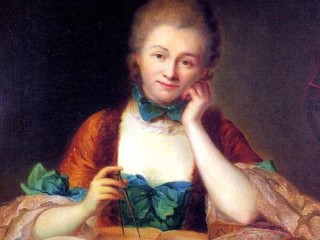
Emilie Du Chatelet biography
Date of birth : 1706-12-17
Date of death : 1749-09-10
Birthplace : Paris, France
Nationality : French
Category : Science and Technology
Last modified : 2011-05-27
Credited as : Mathematician and physicist, Age of Enlightenment, theories of Isaac Newton
Émilie du Châtelet played a major role in the scientific revolution of the eighteenth century. By popularizing the theories of Isaac Newton she brought them more widespread acceptance in Europe, where most people still followed the ideas of Rene Descartes. Chatelet's scientific contribution has been largely overshadowed by her relationship with the philosopher Voltaire.
Born Gabrielle-Emilie Le Tonnelier de Breteuil in Paris on December 17, 1706 into an aristocratic family, she received an exceptional education at home, which included scientific, musical, and literary studies. In 1725, she married the marquis du Chatelet, who was also the count of Lomont. It was a marriage of convenience, but she nevertheless had three children with him. After spending some years with her husband, whose political and military career kept him away from Paris, the marquise du Chatelet returned to the capital in 1730.
Initially leading a busy social life, Chatelet became the lover of the philosopher Francois-Marie Arouet de Voltaire in 1733. One of the greatest intellectual figures of 18th-century France, Voltaire recognized her exceptional talent for science, and encouraged her intellectual development. Chatelet consequently embarked on a study of mathematics, taking private lessons from the prominent French philosopher and scientist Pierre-Louis Moreau de Maupertuis. Both Voltaire and Maupertuis were enthusiastic supporters of Isaac Newton's scientific theories and world view, and it seems that the marquise was, as a result, immersed in Newtonian philosophy.
In 1734 Voltaire faced arrest because of his criticism of the monarchy. He was offered sanctuary at Chatelet's chateau at Cirey, in Lorraine, where they spent many productive years. The two welcomed Europe's intellectual elite, thus creating a remarkable cultural center away from Paris. Chatelet was involved in a variety of literary and philosophical projects, eventually concentrating on the study of Newton's philosophy. She assisted Voltaire in the preparation of his 1738 book, Elements of Newton's Philosophy.
In 1737, Chatelet, like many other 18th-century scientists, attempted to explain the nature of combustion, submitting an essay entitled "Dissertation sur la nature et la propagation du feu," as an entry for a contest organized by the Academie Royale des Sciences. Voltaire also participated in the contest, but was unaware of her work. When Leonhard Euler and two other scientists were declared the winners, Voltaire arranged that Chatelet's essay be published with the winning entries. In her study, she correctly argued that heat was not a substance, a view defended by the proponents of the phlogiston theory, which the great French chemist Antoine-Laurent Lavoisier empirically disproved in 1788. Furthermore, Chatelet put forth the original idea that light and heat were essentially the same substance.
While writing her Institutions de physique, a work on Newtonian physics and mechanics, Chatelet became acquainted with the ideas of Gottfried Leibniz, particularly his conception of forces vives, which she accepted as true. While Rene Descartes described the physical world geometrically as extended matter, to which force can be applied as an external agent, Leibniz defined force as a distinctive quality of matter. In view of Chatelet's general Newtonian orientation as a scientist, her passionate interest in Leibnizian metaphysics, which essentially contradicts the Newtonian world view, may seem odd. However, as Margaret Alic argues, the marquise sought a synthesis of the two world views. "Institutions," Alic has written, "remained faithful to Newtonian physics, but Newton's purely scientific, materialistic philosophy did not completely satisfy the marquise. She believed that scientific theory demanded a foundation in metaphysics and this she found in Leibniz. She never doubted that Leibnizian metaphysics was reconcilable with Newtonian physics, as long as the implications of the Newtonian system were limited to empirical physical phenomena." Chatelet's acceptance of the metaphysical foundations of science was an implicit rejection of any mechanistic world view, Cartesian or Newtonian. French scientists, most of whom tacitly accepted the Cartesian scientific paradigm, found the marquise's ideas offensive. For example, the eminent Cartesian physicist and mathematician Jean-Baptist Dortous de Mairan, whom she had singled out for criticism, responded sharply in 1741, representing a majority view which Chatelet was unable to refute alone.
Retreating from the philosophical war between the Cartesians and the Leibnizians, Chatelet focused on her Newtonian studies, particularly the huge task of translating Newton's Principia mathematica into French, an undertaking which she devoted the rest of her life. An excellent Latinist with a deep understanding of Newtonian physics, she was ideally suited for the project. Despite many obstacles, which included a busy social life and an unwanted pregnancy at the age of 42, Chatelet finished her translation. On September 4, 1749, she gave birth to a daughter, and died of puerperal fever shortly thereafter. Her translation of Newton's work remains one of the monuments of French scientific scholarship.
















